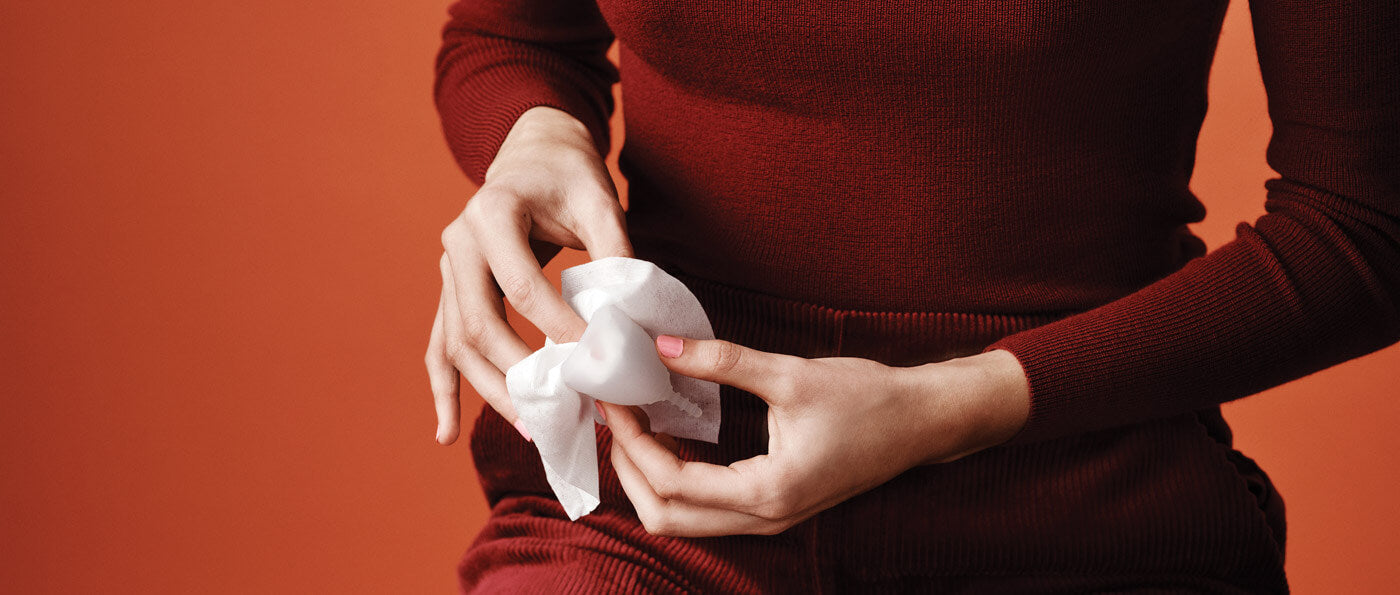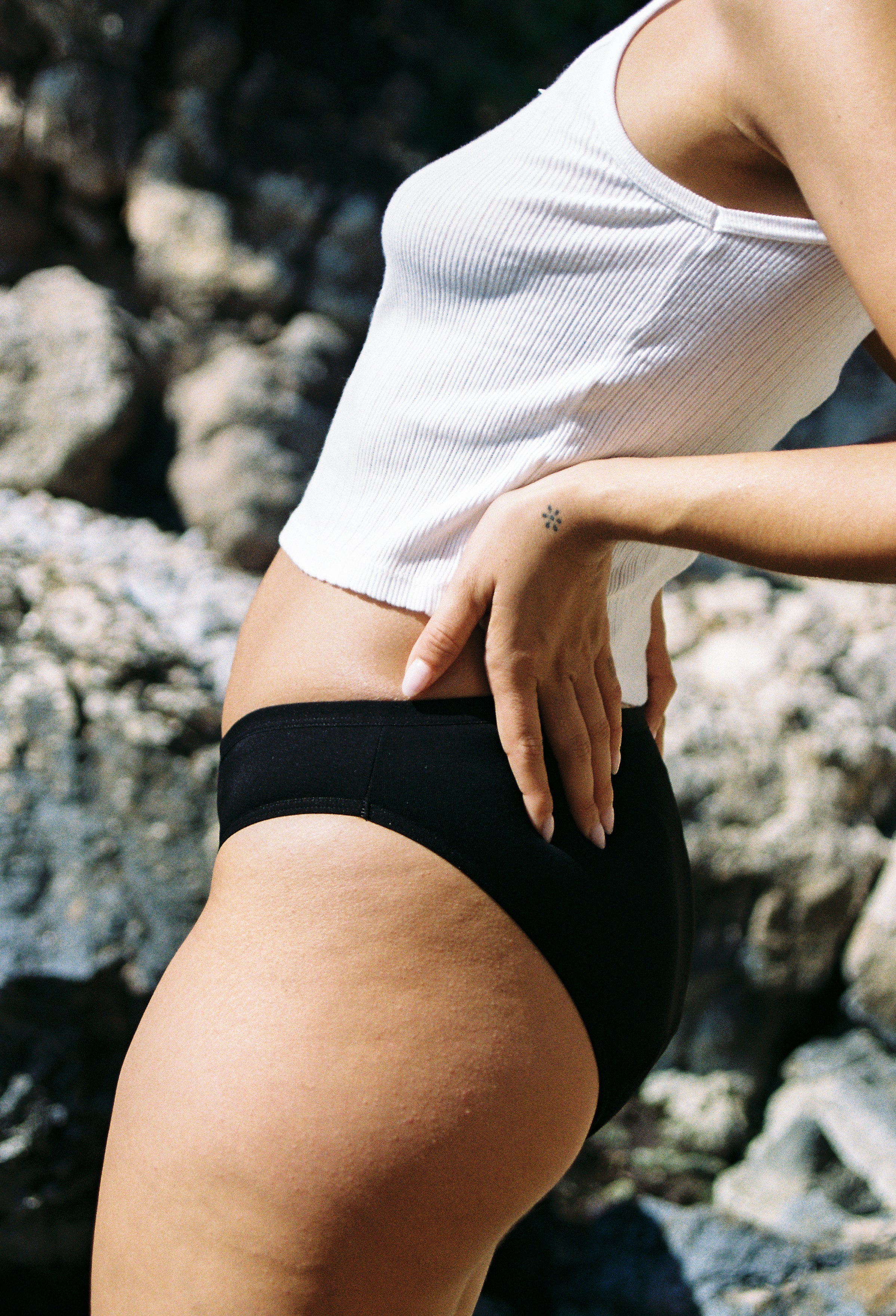When you start using a menstrual cup, it’s important to know how to clean it, how long to boil it for, and how to effectively store and sanitise it. It can be hard to know what soaps or cleaning solutions are safe, how to remove menstrual cup stains, and when you should replace your cup. We’re here to answer all your questions and help make your transition to menstrual cups easy and painless!
What is a menstrual cup?
A menstrual cup is a sustainable and reusable period product usually made from medical-grade silicone or TPE (thermoplastic) and free from harmful chemicals and BPA (Bisphenol A). They are a flexible and easy-to-use tampon alternative that will last you for years. They are just as safe and effective at stopping leaks as tampons.
Ours are made from medical-grade silicone and are colourless to avoid using colour additives. They can be used for up to 12 hours at a time and are comfortable, safe, and a better choice for your body and the planet!
So, you just bought a menstrual cup – now what?
You will need to boil your menstrual cup before the first time you use it. This is to sanitise the product, so that your cup is safe to use when you are ready to start using it.
You’ll need a few things:
- pot
- stove
- water
- whisk (optional)
After washing your hands, check the menstrual cup to make sure the air holes at the top are open and not blocked. Then grab a pot that is big enough to contain - and completely submerge - the menstrual cup. Fill the pot with water, then bring it to the boil. Place the cup in the boiling water, making sure it is fully submerged. Then simply let it boil for 3 to 5 minutes, keeping an eye on the cup to make sure it doesn’t burn, and stays beneath the water.
A tip you can use is to put your cup inside a wire whisk to prevent it from coming into contact with the bottom of the pot, but this is not necessary.
How Long Should You Boil Your Menstrual Cup?
Boiling your menstrual cup is a quick and effective method of sterilization. A common question is how long the boiling process should last. For optimal cleanliness, it's best to let the cup boil for at least 3 to 5 minutes. Keeping the cup submerged in boiling water for this duration is crucial to eliminate any bacteria or microorganisms.
Do You Have to Boil Your Menstrual Cup Every Time?
Boiling your menstrual cup before the first use is essential. After that, you have options. You can boil the cup between cycles, or if you prefer, you can simply wash it with a menstrual cup cleanser or a mild, unscented, and oil-free soap. Boiling every time is not strictly necessary but is recommended for thorough sterilization.
What to use to clean your menstrual cup
We touch a lot of things throughout the day, from stair railings, keyboards, phones, door handles, and so on – making sure to wash your hands can prevent infections. Always wash your hands with mild soap and warm water before and after handling your cup.
Thankfully, it is not much work to clean your cup between uses, but there are some cleaning products you should avoid to prevent infection, reactions, or uncomfortable sensations like burning or itching. Whether you are camping, out on the town, or at home, your cup can easily and safely be taken care of without worry.
What’s okay
There are quite a few options you can try when cleaning your cup to see what works best for you. You should use things like a dedicated menstrual cleanser such as our cup wash that is pH-balanced and designed to be free of fragrance and not cause irritation. Any other mild, unscented, and oil-free soap can safely get the job done too.
What to avoid
Your vagina is self-cleaning and can be sensitive to harsh or unfamiliar substances, so it’s important to use things that will be mild and gentle when cleaning your menstrual cup. You should avoid things like:
- Hydrogen peroxide
- Bleach
- Baking soda
- Laundry or dishwasher detergents and soaps
- Soaps with fragrance
- Oil-based soaps
- Rubbing alcohol
- Vinegar
Daily cleaning while on your period
Depending on your flow, and size of your menstrual cup, they can be worn up to 12 hours at a time and will only have to be washed up to two times a day. It’s essential to clean your cup because this helps to remove bacteria, decreases build-up, and helps to prevent stains and odour.
During your period:
- Remove the cup
- Empty blood into the toilet
- Rinse cup with cold water
- Now you’re good to re-insert the cup!
How to wash your menstrual cup when out and about
If you’re going to be using public toilets, go on a camping trip, or might be somewhere else with no access to running water, you can also use specially made wipes to clean your menstrual cup. Just empty the cup as normal and use a menstrual cup wipe to clean it and then reinsert and sanitise your hands again! If you don’t have any wipes, you can use toilet paper; just make sure to get all the tissue off before reinsertion. Then as soon as you are home, be sure to clean your menstrual cup as usual.
When camping, or going days without access to running water, pour the flow into a small hole in the ground (as you would with regular organic waste), use bottled water to rinse your cup, dry it with a clean tissue, then reinsert. When travelling with your cup, make sure to store it in its pouch to keep it clean.
Sanitising between periods
When your period is over you need to sanitise your menstrual cup. The most effective way is to boil your menstrual cup just as you did before you started using it. You can choose to boil it on the stove or even use a special container. It is recommended to boil it for 3 to 5 minutes then it’s ready to be stored until your next cycle.
How to store your menstrual cup
Most menstrual cups come with a breathable cotton bag, and ours is made from organic cotton. It’s important to never store your cup in a plastic bag or airtight container, and this could cause a breeding ground for bacteria.
Let’s talk about those ‘what ifs’
What to Do if Your Menstrual Cup Falls in the Toilet
If your menstrual cup happens to fall into the toilet, refrain from using it immediately. The best course of action is to thoroughly boil the cup to ensure it's sanitized. This incident may seem alarming, but a proper sterilization process will render the cup safe for use again.
What if my menstrual cup is stained?
Staining and discoloration are bound to happen. If your menstrual cup is stained, it doesn’t mean that it’s dirty, or in need of replacement. There isn’t any reason to try and remove stains unless it is for cosmetic reasons. You can remove stains by leaving the cup out in direct sunlight for 24 hours.
What if my cup has an odour?
Regular maintenance and cleaning can help to combat any odours from your menstrual cup, but you can also leave it out in direct sunlight to remove any odours as well.
When to replace your cup
You should replace your cup if there are any signs of cracking, splitting, or tearing, if your cup has a chalky residue or becomes sticky to the touch. Extreme discoloration, thinning, and foul odour that cannot be removed is a sign it’s time for a new cup as well. They have a relatively long shelf life and usually don’t need to be replaced for 2-3 years.
A safer and easier period
Keeping your menstrual cup clean and sanitised is important for your general well-being. As long as you clean your cup and follow the sanitisation and maintenance recommendations, your cup will last you years and also save you spending lots of money on other period products each month.
One final note: if at any time you develop any type of infection that could possibly be related to your menstrual cup, stop using it immediately and contact your doctor.
Frequently Asked Questions (FAQs)
How to boil a menstrual cup?
Boiling a menstrual cup is a straightforward process. After washing your hands, check the menstrual cup to make sure the air holes at the top are open and not blocked. Then grab a pot that is big enough to contain - and completely submerge - the menstrual cup. Fill the pot with water, then bring it to the boil. Place the cup in the boiling water, making sure it is fully submerged. Then simply let it boil for 3 to 5 minutes, keeping an eye on the cup to make sure it doesn’t burn, and stays beneath the water.
What should I do if I dropped a menstrual cup in the toilet?
If your menstrual cup falls into the toilet, do not reinsert it! Instead, make sure to boil the cup to sanitize it thoroughly before using it again. Accidents happen, but it's important to ensure your cup is clean and safe to use before reinserting it.
How to store a menstrual cup?
Most menstrual cups come with a breathable cotton bag for storage. It’s important to never store your cup in a plastic bag or airtight container, as this could create a breeding ground for bacteria. Always ensure your menstrual cup is thoroughly dried before storing it.
How often should I replace my menstrual cup?
With proper care, a menstrual cup can last for several years. However, it's recommended to replace your cup if there are any signs of cracking, splitting, or tearing, if your cup has a chalky residue or becomes sticky to the touch. Extreme discoloration, thinning, and a foul odour that cannot be removed are also signs that it's time for a new cup.
Can a menstrual cup cause infections?
Menstrual cups are generally very safe to use. However, like any other period product, they need to be used and cleaned properly to prevent infections. If at any time you develop any type of infection that could possibly be related to your menstrual cup, stop using it immediately and contact your doctor.
Can a menstrual cup cause odours?
Regular maintenance and cleaning can help to combat any odours from your menstrual cup. However, if your cup develops a persistent odour, it may be a sign that it needs to be replaced.
How can I remove stains from my menstrual cup?
Staining and discoloration are normal and do not necessarily mean your cup is dirty. However, if you want to remove stains, you can leave the cup out in direct sunlight for 24 hours. This can often help to lighten stains and remove any odours.
In conclusion, maintaining a menstrual cup might seem daunting at first, but with some simple routines and care, you can ensure that your menstrual cup remains clean, safe, and ready to use for years to come. By choosing a menstrual cup, you're not only making a sustainable and cost-effective choice, but you're also taking a step towards a safer and easier period. Remember, if at any point you experience any issues or discomfort, don't hesitate to consult your healthcare provider.






